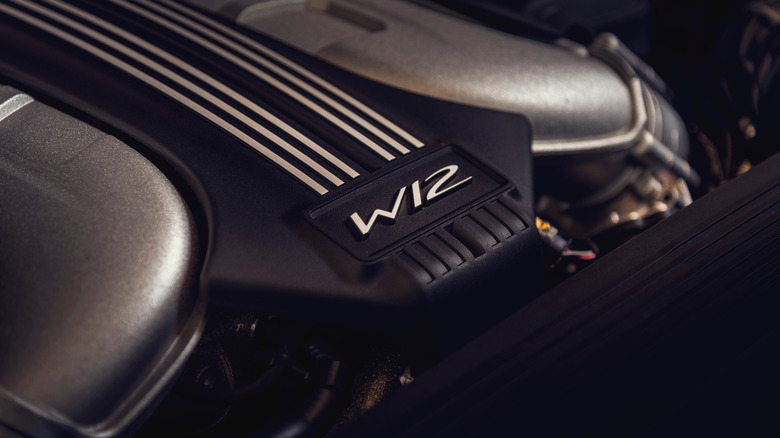
The Volkswagen Group/Bentley 6.0-liter Goldilocks W12 relic was discontinued in spring of 2024, and it slotted neatly between the Papa Bear Bugatti W16 and the Baby Bear VW W8 and VR6 (which are also gone). A Mama Bear W10 was prototyped, but never produced. In its heyday, W12s were more than just welded-together VR6s (okay, that's pretty accurate, though), the W12 was a sign that a buyer wanted to go fast with utter buttery smoothness. Still, as beloved as the VW/Audi/Bentley W12 is and was, the design has as many pros as it does cons. Pros are that it has relatively compact dimensions and reasonable weight, and it's smooth and powerful. The cons are that it's complex, expensive to build and maintain, heavier than comparatively powerful modern V8s, and gets poor fuel economy.
Let's toot the W12's horn before getting into the negatives. The W family was based on the VR6, a technical marvel that let VW put a six-cylinder where a four-cylinder originally lived in the Corrado. The VR6 let VW get away with one fewer head than a V6 and avoid an inline-6's length, as expertly demonstrated by Hagerty's Jason Cammisa on YouTube. In W12 form, engineers achieved a V12's balanced and silky demeanor while cramming 12 cylinders in relatively little space.
The difference is significant, too. Lamborghini's Aventador V12 is over 30 inches long, but a VW Phaeton's W12 is just over 20 inches. The W12 also suffers no significant weight penalty over competitors' V12s. BMW's M70 V12 weighs 529 pounds, while the Phaeton W12 is only a little heavier at 540 pounds, though it makes way more power than the BMW engine. The Phaeton W12 made up to 444 hp, while the hottest version of the M70 in BMW's 850CSI made 375 hp.
 Bad Shot Media/Shutterstock
Bad Shot Media/Shutterstock
Unfortunately for fans of base 12 systems, you just don't need more cylinders to make more power or achieve turbine-like smoothness anymore. You don't even need cylinders. Yes, V12s are inherently well-balanced thanks to their even power pulses, at least when they're set at 60, 120, or 180 degrees, but electric powertrains are as smooth as a Morgan Freeman narration. Torque is perfectly linear and instantaneous, and there's no need for a transmission that can interrupt power with shifts. And if you say you can put a V12 in front of a CVT to maintain its smooth character, bite your tongue.
Also, it's not like smooth V8s are impossible, as vintage Bentley and Rolls-Royce 6.75 V8s aren't exactly known for harshness. As for weight, as light and proportionally advantageous as the W12 is for a 12-cylinder, smaller, lighter V8s can be just as powerful. For example, the C8 Corvette's LT2 V8 weighs 472 pounds and makes 495 hp to the Phaeton's 540 pounds and 444 hp.
Another pair of cons for the W12 were its fuel thirst and emissions. Despite the final iterations of Bentley's W12 making 34% more power and 54% more torque with 25% less CO2 output than earlier examples, it can't compete with electrification and hybridization. Bentley was the last brand still using W12s, and it believes hybrids and EVs will better suit its goals for refined, consistent, effortless power delivery while lowering its carbon footprint. According to Bentley, its new 740+ hp twin-turbo V8/hybrid setup makes more power and torque than its old W12, but produces way less CO2.
 Sjo/Getty Images
Sjo/Getty Images
Even if emissions and efficiency weren't an issue with the W12, complexity certainly is. The best example of this is how the engine avoids giving each of the four cylinder banks its own pair of camshafts, creating an 8-cam monstrosity; the W12 operates with just two cams per head by employing rocker arms. Instead of pushing directly on the valves, each cam instead pushes on the arms, which run to the splayed cylinders. Now, while you get fewer camshafts, there are more moving parts, increasing weight and complexity.
Owners and sources report that VW's W12 engines also feature spindly, spider-leggy 13-millimeter-thick connecting rods because the crankshaft has to be shorter than in a standard V formation. By comparison, a Corvette LT2's connecting rods are almost 24 millimeters thick. The engine's compactness also makes it tough to keep running temps low, and VW had to ensure proper cooling by giving the W12 two water pumps and a pair of fan systems, one hydraulic and one electric.
So there, the W12 isn't perfect. But automotive legends aren't built on perfection. They're built on personality, individuality, exclusivity, and how they make us feel. And boy, howdy, there are few engines like the W12. We can thank the Teutonic personality that is former VW CEO Ferdinand Piech that we got the W12, in addition to the Bugatti Veyron's truly cartoonish quad-turbo W16, which was born from a train ride sketch. The W12 was a bit like a Rube Goldberg machine: exceedingly complex with a simple goal. In this case, that goal was to be a bottomless well of smooth, effortless thrust.















Facebook Conversations